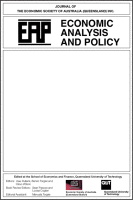Economic Analysis and Policy
Número:
2
Publicado:
Clasificación JEL:
E26, E32, H26, O17

Lo más reciente
Leonardo Fabio Morales, Leonardo Bonilla-Mejía, Didier Hermida-Giraldo, Francisco Javier Lasso-Valderrama, José Pulido
Leonardo Fabio Morales, Juan Chaparro-Cardona, Eleonora Dávalos, Nataly Corredor-Martinez
Oscar Botero-Ramírez, Andrés Murcia, Hernando Vargas-Herrera
Within the literature on business cycles featuring underground activities, there is an approach based on the arguable premise that these are countercyclical. This paper develops a real business cycle model without such an assumption. Preferences are additively separable in formal and underground labor. Further, leisure time is spent on irregular work and non-market activities. Simulations permit examining how the model performs and comparing the results with related findings. Also, computational experiments allow analyzing the effects of taxes, enforcement and tastes for underground labor on aggregate fluctuations. These experiments offer a comprehensive view of the cyclical implications of the shadow economy.
